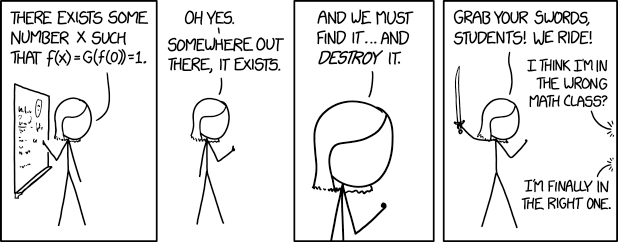
God’ is one of those words we think we understand, but many of us really don’t. Both believers and unbelievers often fall prey to a misguided idea of what the writers of the Nicene Creed meant by the word ‘God’.
Consider this description of God as an example:
God is an immensely powerful spiritual being, more powerful than anyone else in the Universe. He is invisible; he lives in heaven, but he can also be everywhere at once. He created the world a long time ago, and sometimes intervenes in the world today to perform miracles or answer prayers. His arch-enemy is another powerful spirit called Satan, but God is more powerful than Satan and will one day defeat him.
Almost everything about the above paragraph is either misleading or false from a traditional Christian point of view, yet it is not far off from the way many people today think about God. If we want to come up with a better definition, we need to understand, first that there are different kinds of reality, and second, that God belongs to his own unique kind of reality. Let’s use analogies to make each of these points.
God is like the number 2
Let’s have a look and a laugh at this XKCD webcomic.

What makes this comic funny is that the maths teacher is confusing two types of reality:
-
Physical, contingent realities whose existence is contingent (might or might not have existed), that exist in a particular place and time, and that can be destroyed.
-
Non-physical, non-contingent realities whose existence is necessary (cannot not exist), that are not in space or time at all, and that cannot be destroyed.
The maths teacher is treating a number as if it had the first kind of reality when in fact it has the second. It doesn’t make sense to ‘find and destroy’ a number. If the number 2 ceased to exist, what would 1+1 then be equal to? What would it mean if you saw more than 1 but less than 3 objects together, or would that no longer happen? Numbers are not the kind of things that you can remove, leaving the rest of the Universe unchanged. They are part of the fabric of reality, and we can’t really conceive a Universe without them.
Now, when we’re talking about God, this is the crucial thing to understand: the kind of reality that God has is more like the reality of numbers than the reality of physical objects. Like numbers, God is intrinsic to the way reality works. Like numbers, God can’t be located anywhere, yet without his presence reality would not make any sense. Like numbers, God can’t be seen, only represented through signs and symbols.
Compared to God, we are like two-dimensional beings
Let me introduce you to Flatty.

Flatty is an entirely two-dimensional creature, living in a two-dimensional world called Flatland. In this world, there is no up and down, only left, right, forward, and backward. There are no spheres, only circles. There are no cubes, only squares. If I draw a square around flatty, it imprisons him. He cannot go over it or under it, because there is no such thing as ‘over’ or ‘under’ in Flatland. If I draw an object in front of Flatty, it looks to him as if it appeared out of nowhere.
Now, imagine you could talk to Flatty. Your voice would seem to be coming from nowhere, since he can’t see anything in three dimensions. How could you persuade him that you exist and he’s not going crazy? Perhaps you could press your finger on the surface of flatland. The fingerprint would appear like a strange oval shape, but that would only be the tiniest hint of what you look like. You could try to explain that you’re above him, but the word ‘above’ is meaningless for him so he would not understand.
Suppose Flatty was persuaded that you existed. How could he prove to other flatties that you existed? He has no words to describe you with except the ones you’ve given him, which have no meaning in a two-dimensional Universe. He can’t point to you, and he can’t offer any evidence. All evidence he might have would be two-dimensional, which misses the kind of reality he wants to prove.
Now the point of this analogy is that we are like Flatty in relation to God. We lack the language to describe God because his reality is so much greater than ours that our minds are not equipped to conceive or describe it. God can speak to us – he can even make strange appearances in the physical world sometimes, but those appearances only convey the tiniest hint of who he is.
This is what the Christian tradition has always meant when it says that God is ‘transcendent’. The word ‘transcendence’ is an attempt to give a name to something we have no concept of and no ability to fully comprehend: the idea that there is a reality beyond the three-dimensional reality that we can see and experience, and that God inhabits that reality.
Let’s return to the misleading definition of God we quoted above and correct some of the points:
-
It is true to say that God is invisible, but this is not an accident, as if God could have been visible. It’s part of the very nature of God that he cannot be seen, because the only things that can be seen are things that belong to the three-dimensional world. (If you think about it, numbers can’t really be ‘seen’ either. The way we write the number 2 is just as symbol to represent something that has no visible form. Even if we see two objects together, we are not seeing the number 2 itself, merely an instance of its use in one particular place and time.)
-
God does not ‘live’ in heaven as if he were an object that could be located somewhere. ‘Heaven’ is itself a name for the transcendent reality that we cannot fully conceive (this is more obvious in the biblical languages, and in French, German, and Spanish, where the word for ‘heaven’ and the word for ‘sky’ are the same, yet nobody is confused and thinks you’re talking about the sky). When we say that God is in heaven, we mean that God’s reality is more tangible and present there than it is here on earth, although that will not always be the case.
The other misleading aspects of that initial quotation will be addressed in the next article on the doctrine of creation.
Why this is not apologetics
None of this counts as an argument for the existence of God, even if it makes a difference to how such arguments would go. The above should not be taken as evidence that God exists, but as providing a definition of God that we need before any productive argument can begin. The reason so many atheists and theists seem to be talking past each other is that they so often start with different definitions of God without realising it. David Bentley Hart puts it this way:
The most pervasive error one encounters in contemporary arguments about belief in God … is the habit of conceiving of God simply as some very large object or agency within the universe, or perhaps alongside the universe, a being among other beings, who differs from all other beings in magnitude, power, and duration, but not ontologically.
One example of this mistake is what Richard Dawkins says in the following:
I have found it an amusing strategy, when asked whether I am an atheist, to point out that the questioner is also an atheist when considering Zeus, Apollo, Amon Ra, Mithras, Baal, Thor, Wotan, the Golden Calf and the Flying Spaghetti Monster. I just go one god further.
Dawkins has cleverly turned the tables, making it look as if all the religions disagreed with each other, when in fact most of them agree against atheism on the question of God, and only disagree much further down the line. It is as if someone were to count English accents as different languages, and then propose making Flemish the international language because more people speak it than any of the varieties of English.
More specifically, Dawkins’ mistake is to confuse capital ‘G’ God and lowercase ‘g’ gods which is not the plural of ‘God’ in any major religion. Lowercase ‘gods’, whether they exist or not, still live inside the Universe and are part of it like you and me. The Bible itself, even though it is a monotheistic book, uses the term ‘gods’ in this way (see e.g., Psalm 82, 86, 98).
FAQs
Is this really a biblical conception of God? Why are there so few Bible quotes in this article?
The point of this article is to explain what the writers of the Nicene Creed meant when they used the word ‘God’. They believed that their conception of God was derived from the Bible and accurately reflected the biblical view. Their conception of God has come to be called ‘Classical Theism’, which is the mainstream position taken by the majority of theologians and denominations throughout Christian history. In recent years, some academic theologians called ‘open theists’ have argued that Classical Theism did not come from the Bible but from ancient Greek philosophy, and is therefore not properly Christian. If they are correct, it means that they have understood the Bible better than almost every theologian in the first fifteen centuries of the Church, including the writers of the Nicene Creed. Their argument has not been accepted by most churches and denominations, and it depends on a not-universally agreed understanding of how Christians ought to interpret the Bible. To explain why I think the Bible supports Classical Theism would be to write a completely different, and much longer, article. There are many resources already out there that show how the classical conception of God is not only derived from the Bible, but rejects a lot of Greek philosophy in favour of the Bible. If you are interested in this debate, you might consider the following resources to start with: Paul Tyson, Returning to Reality: Christian Platonism for Our Times (Wipf & Stock, 2014); Andrew Davison, Participation in God: A Study in Christian Doctrine and Metaphysics (CUP, 2019); Simon Oliver, Creation: A Guide for the Perplexed (Bloomsbury, 2017); Paul L. Gavrilyuk, The Suffering of the Impassible God (OUP, 2004).
What about Jesus? Doesn’t this conception of God leave out the most central Christian tenet, that Jesus is God?
To say that ‘Jesus is God’ has no meaning unless you first have a definition of God that the word ‘Jesus’ can apply to. That is why the Bible starts by building up a conception of God in the Old Testament, before revealing in the New Testament that this same God came among us in the person of Jesus. That’s why it’s misleading to say (as some Christians do) ‘If you want to know what God is like, look at Jesus’. It’s true at the level of God’s character, but not at the level of God’s nature. If you are interested in this question, I would suggest reading Rowan Williams, Christ the Heart of Creation (Bloomsbury, 2018).
This definition of God makes him seem impersonal. Doesn’t Christianity teach that God is personal?
It’s true that God has chosen to relate to us as one person relates to another, and in that sense we can call God ‘personal’. But we must be careful of letting that idea run away with itself, until we imagine God to be like a human being, only bigger and more powerful. This is called the mistake of anthropomorphising God. If you’re interested in avoiding anthropomorphic conceptions of God, I would suggest starting with David Bentley Hart, The Experience of God: Being, Consciousness, Bliss (Yale University Press, 2014).




